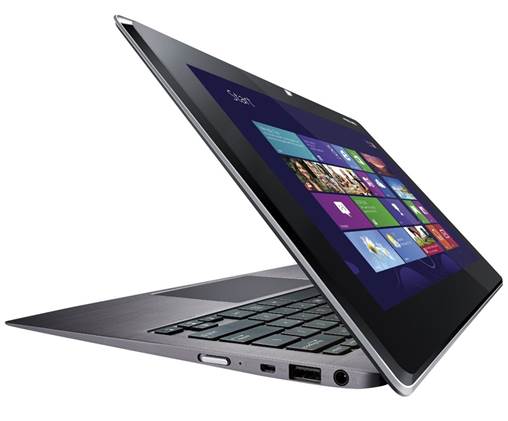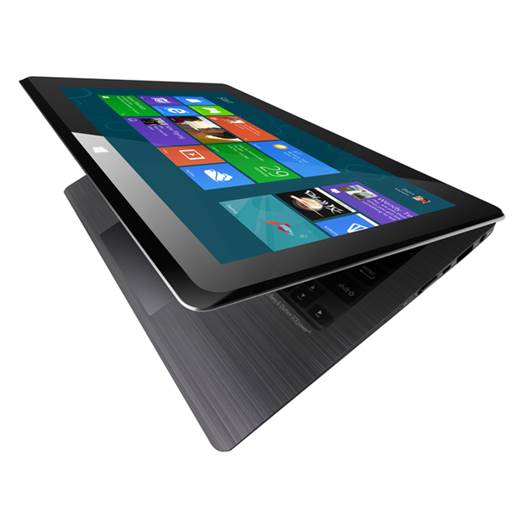Twin
From purely a usability perspective, the
frontrunner has to be the Asus Taichi 21.While all the other hybrids here find
elaborate ways to shift a screen from one position and orientation into
another, the Taichi slaps a second screen on the lid. There’s no worrying about
how to convert when you’re crammed in on the train; you just close it. Often
the most obvious solution is the best.

While
all the other hybrids here find elaborate ways to shift a screen from one
position and orientation into another, the Taichi slaps a second screen on the
lid
It can’t quite get past the same hang-ups
as the others – although it’s the lightest here, 1.25kg is still a bit much for
a handheld but it can be used effectively on a lap or a desk, or while standing
up, with a simple transition between the two. It feels like the most logical
design from the user’s perspective, but its insurmountable issue is that using
two screens pushes up the price.
Compromise
None of the hybrid form factors here can
truly claim to get everything right. A sliding screen is easy to handle on the
move, but comes with a reduction in laptop comfort. The ThinkPad Twist is hard
to convert; the Yoga gives you that awkward feel of keys under your fingers as
you hold it; the Taichi’s two screens take their toll on your wallet. And the
big problem all hybrids have is their tablet weight.
If you accept there will be compromise,
however, the hybrid can offer power and versatility. There’s no denying they
work best as laptops – the weight will have to come down before we’d put their
tablet modes in the same bracket as a standalone device – but they do at least
allow both sides of Windows 8 to shine. The problem for now is that a
touchscreen laptop does too, and so does a tablet with a removable keyboard and
they’ll both cost you considerably less than one of these hybrids.
Asus Taichi 21
Asus pioneers a clever, dual-screened
design, but despite a high specification and luxurious design, the price is too
high
Price: $1,875
Ratings: 4/6

The
glossy tablet display is protected with Gorilla Glass
Asus’s engineers have clearly been on a
lateral-thinking course. Instead of producing an intricate hinge mechanism to
turn the Taichi 21 from a laptop into a tablet, they’ve simply slapped an extra
screen on the back of the lid.
It’s a far cry from the double- jointed
circus act of the Lenovo IdeaPad Yoga 13, or the Dell XPS 12’s balletic,
spinning display, but there’s much to like about the Taichi’s simple approach.
To switch from laptop to tablet mode, all you do is close the lid. In this
mode, a bundled stylus and pressure- sensitive N-trig digitizer layer add
another dimension to simple finger-driven touchscreen operation, and with the
lid open, the Windows desktop can be mirrored on both screens, or extended
across them.
It’s a flexible thing, and each of the
Taichi’s 11.6in, Full HD, IPS displays are of commendable quality. The color
temperature of both is on the warm side, but this lends images a pleasant rosy
tone, and the 965:1 contrast ratio is the month’s best. Our only qualm concerns
the backlight: the laptop display’s 222cd/m2 brightness and the
tablet panel’s 245cd/m2 result could be better.
At this price we’d expect a top-notch
specification, and here the Taichi 21 delivers. The Core i7-3517U processor
scored 0.66 in our benchmarks – third-fastest in this month’s Labs and there’s
a 256GB SSD to help keep Windows 8 nippy. It’s no gaming system, though: as
with all this month’s hybrids, Intel’s HD Graphics 4000 struggled when tasked
with anything beyond Crysis’ Low quality settings. Battery life isn’t a strong
suit, either: the Taichi lasted just under five hours in both laptop and tablet
modes, which are the worst results in this Lab.

In
laptop mode, the Asus is up there with the best Ultrabooks
Ergonomically it’s better news for the
Taichi at least in laptop mode. The Scrabble-tile keys are comfortable, the
layout is perfect, and the touchpad includes support for Windows 8’s edge
gestures. And, neatly, Asus has employed a matte finish on the internal laptop
display to keep distracting reflections to a minimum. All in all, it’s more than
a match for any 11.6in Ultrabook.
Again, though, there are niggles.
Transitions between the laptop and tablet modes take around three seconds, and
as the laptop display isn’t a touchscreen, we often found ourselves reaching
out to perform a fruitless prod.
Switch to tablet mode and the Taichi 21
isn’t entirely convincing. The hinged design allows the touchscreen display to
be used easily at a desk, but it still isn’t light enough for handheld use.
Although the Taichi’s 1.25kg weight makes it the lightest hybrid here, it’s
still almost double the weight of an iPad.
The two-screen design is undoubtedly
elegant, but the poor battery life and dim displays are pressing concerns, and
those two screens don’t come cheap. At $2250 inc VAT it’s by far the priciest
hybrid in this Labs, and as rivals deliver a more convincing all-round
performance for less, the Asus Taichi 21 flounders.